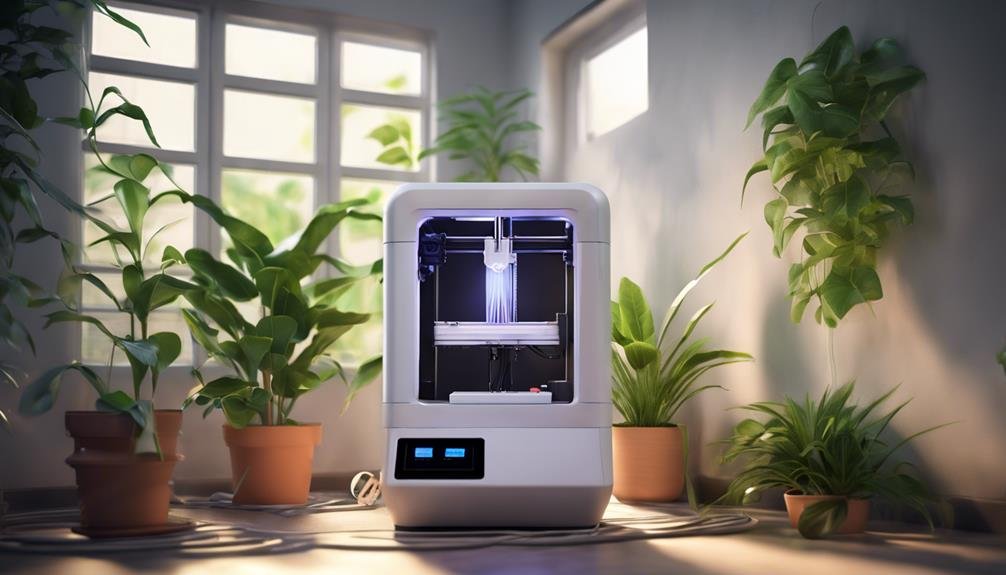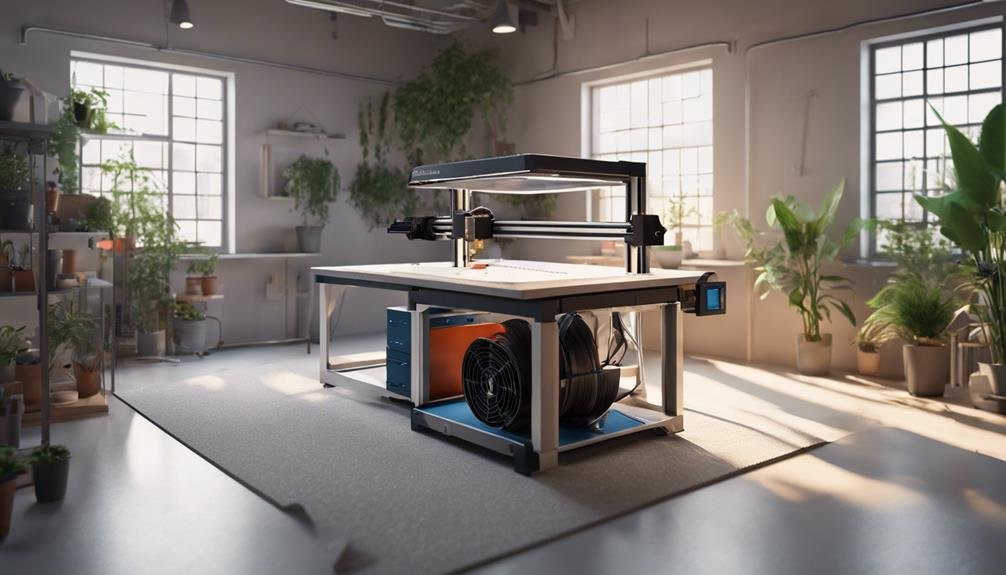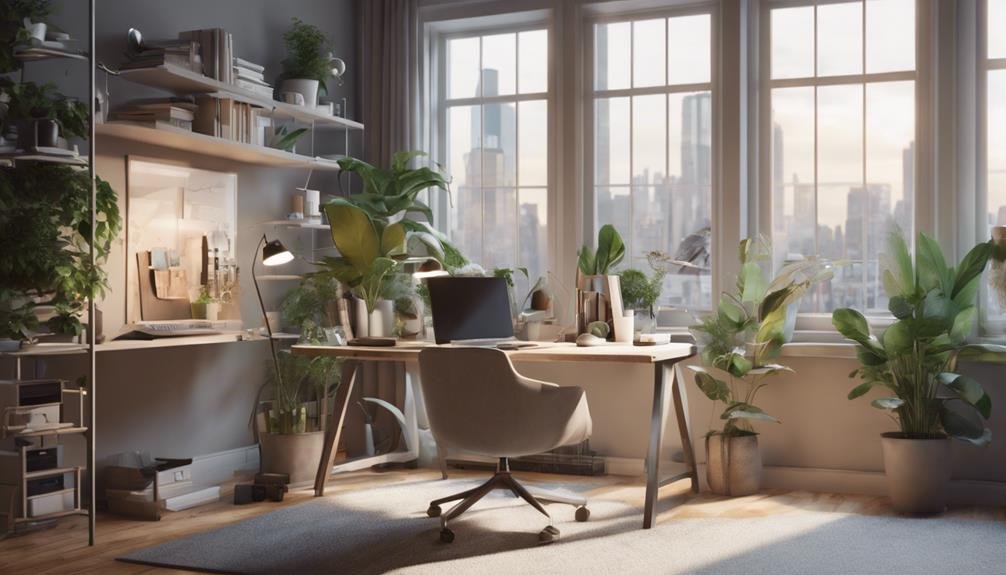When deciding where to place your 3D printer, take into account the space's environmental factors, as they have a notable impact on print quality and safety. Ideal conditions include a temperature between 15°C and 30°C, humidity below 50%, and proper ventilation to address material flow problems and warping. A well-ventilated area, like near a window or with an extractor, helps maintain air quality. By selecting a location with stable temperature and humidity, you'll guarantee ideal printing conditions. As you set up your printer, consider these factors to minimize potential issues, and delve into the importance of ventilation, temperature control, and dust prevention to optimize your printing experience.
Environmental Factors to Consider
When establishing your 3D printer, you'll want to take into account the environmental factors that can make or break a successful print job, as the right temperature, humidity, and ventilation can greatly influence the quality of your final product.
Temperature, for instance, plays a vital role in print quality, with ideal conditions ranging from 15°C to 30°C. High humidity levels above 50% can be harmful to your printer's electronic components and printing materials, so it's important to maintain a balanced environment.
Proper ventilation is key to controlling temperature and humidity, ensuring that your printer operates within a stable range. A well-ventilated area with fresh air can help mitigate issues like material flow problems and warping. You can achieve this by placing your printer near a window, in a basement with an extractor, or in a cabinet with a filter.
Ideal Room Conditions for Printing
By establishing your 3D printer in a room with a stable temperature between 15°C and 30°C, you'll be creating an ideal environment that promotes ideal printing conditions. This temperature range guarantees that your printer's electronic components and printing materials remain stable and functional.
Moreover, maintaining a humidity level below 50% is crucial. Excessive humidity can harm your printer's electronic components and impact the quality of your prints.
To guarantee excellent printing conditions, consider the following ideal room conditions:
- Temperature: Between 15°C and 30°C to prevent material flow issues, warping, and delamination.
- Humidity: Below 50% to avoid damage to electronic components and printing materials.
- Air Quality: Consider installing a HEPA filter to eliminate airborne contaminants that can influence print quality.
Ventilation and Air Circulation

Having arranged your printer in a room with ideal temperature and humidity conditions, you're now prepared to contemplate the significance of ventilation and air circulation in your printing space. Proper ventilation is vital for 3D printing to reduce fume exposure and maintain air quality.
During printing, filaments emit harmful particles, including ultra-fine particles (UFPs), which can pose health risks if inhaled. Using fans, air purifiers, or exhaust systems can help improve air circulation and remove fumes. Enclosures with filters or exhaust ducts can minimize fume exposure and create a safer workspace.
Adequate ventilation reduces the risk of inhaling potentially harmful emissions from 3D printing materials. It's important to take into account ventilation and air circulation in your printing space to ensure a healthy and safe environment.
Temperature Control for Quality Prints
Set up your printer in a room where you can maintain a stable temperature between 20°C to 30°C, as this range is crucial for producing quality 3D prints. This temperature range allows for best performance and minimizes the risk of warping, cracking, and other issues that can affect print quality.
To achieve the best results, consider the following tips:
- Heated beds and enclosures: These can help prevent warping and cracking of printed objects by maintaining a consistent temperature.
- Adjust nozzle temperature: Tweaking the nozzle temperature can prevent issues like stringing and oozing during printing.
- Monitor ambient temperature: Keep an eye on the room temperature to prevent clogging and jamming of the extruder.
Minimizing Dust and Debris

To guarantee excellent print quality, you should take deliberate steps to minimize dust and debris accumulation around your 3D printer. Regularly vacuuming and wiping surfaces in the printing area can help prevent dust and debris from affecting your prints. Moreover, covering your 3D printer and filament spools when not in use can prevent dust from settling on the equipment.
| Dust and Debris Prevention Methods | Description |
|---|---|
| Regular Cleaning | Vacuum and wipe surfaces in the printing area regularly |
| Covering Equipment | Cover 3D printer and filament spools when not in use |
| Using Dust Collectors | Use vacuum cleaners or dust collectors in the workspace |
| Storing Filament Properly | Store filament in sealed containers with desiccants |
| Cleaning the Nozzle | Clean the nozzle and extruder before and after each print job |
Assessing Space and Storage Needs
Check the available space in your workshop or home to guarantee a comfortable fit for your 3D printer, leaving enough room for easy access and maintenance. A dedicated area in your home office can be an ideal spot, providing a quiet and focused environment for printing.
When evaluating space and storage needs, consider the following:
- Printer dimensions: Confirm the allocated space fits your 3D printer's dimensions, with enough clearance for easy access and maintenance.
- Storage options: Investigate storage solutions like a dedicated cabinet or shelf to store filaments, accessories, and other printing materials.
- Ventilation and airflow: Leave sufficient space on all sides of the printer for proper ventilation and airflow, ensuring smooth printing operations.
Managing Noise and Distractions

By siting your 3D printer in a quiet, low-traffic area, you'll minimize distractions and optimize your printing experience. Make sure to choose a location that's away from high-traffic areas, as the constant flow of people can disrupt your focus during intricate printing processes. Moreover, consider the background noise levels in the room, opting for a space with minimal ambient sound to maintain your concentration.
To further reduce distractions, position your printer on a stable surface to prevent vibrations that can contribute to noise levels. You can also use noise-dampening materials or enclosures to minimize the sound produced by the printer.
In addition, consider dedicating a workspace with sound-absorbing surfaces to create a quieter environment for 3D printing. By taking these steps, you'll be able to focus on your printing projects without interruptions, ensuring a smoother and more efficient printing experience.
Safety Precautions and Security Measures
You'll greatly reduce the risk of accidents and unauthorized access by securing your 3D printer in a designated area with restricted access. This will guarantee that only authorized individuals have access to the printer, minimizing the risk of tampering or theft.
To further boost security and safety, consider the following measures:
- Secure the printer in a cabinet or cage: This will prevent unauthorized access and ensure that the printer is protected from accidental damage.
- Keep pets away: Make sure your furry friends can't access the printer, as they can accidentally trigger the printer or get injured by the moving parts.
- Install a security system: Consider setting up a security system to safeguard your printer from theft or tampering.
Frequently Asked Questions
Is It Safe to 3D Print in Your House?
You're wondering if it's safe to 3D print at home, but you should know that 3D printing can release toxic fumes, putting your health at risk; taking proper precautions, like ventilation and filtration, is essential to minimize exposure.
Is It Better to Have a 3D Printer in the House or Garage?
You'll need to take into account space constraints when deciding between house and garage placement, as the printer's footprint, cord management, and material storage needs will impact your daily workflow and available floor space.
What Is the Best Environment for a 3D Printer?
You need to create an ideal environment for your 3D printer, guaranteeing a stable temperature between 15°C and 30°C, controlling humidity levels below 50%, and maintaining proper ventilation to prevent damage and guarantee successful prints.
Should You Be in the Same Room as a 3D Printer?
When operating your 3D printer, you shouldn't necessarily be in the same room, as proximity can expose you to harmful fumes; consider remote monitoring or ventilation to minimize health risks associated with Printer Proximity.
Conclusion
Now that you've considered the environmental factors, room conditions, ventilation, temperature control, dust minimization, space and storage needs, noise management, and safety precautions, you're ready to set up your 3D printer.
Place it in a well-ventilated area, away from direct sunlight, moisture, and extreme temperatures. Maintain good air circulation, uphold a consistent temperature, and keep the printer clean and dust-free.
By following these guidelines, you'll be able to produce high-quality prints and guarantee a safe and efficient printing experience.
Contents
- 1 Environmental Factors to Consider
- 2 Ideal Room Conditions for Printing
- 3 Ventilation and Air Circulation
- 4 Temperature Control for Quality Prints
- 5 Minimizing Dust and Debris
- 6 Assessing Space and Storage Needs
- 7 Managing Noise and Distractions
- 8 Safety Precautions and Security Measures
- 9 Frequently Asked Questions
- 10 Conclusion